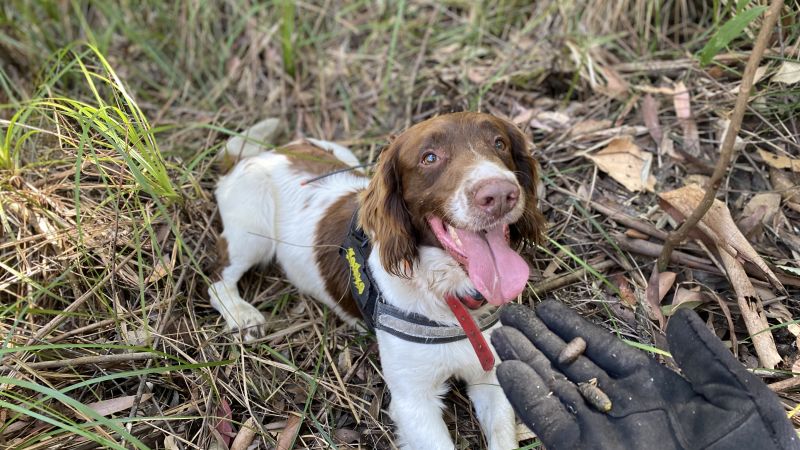**Editor’s Note: Confronting Environmental Challenges**
The environment is at a tipping point, with numerous global challenges that threaten our planet’s ecological balance. Enter the CNN editorial series, *Call to Earth*, dedicated to shining a spotlight on pressing environmental issues while also exploring potential solutions. In collaboration with Rolex’s *Perpetual Planet Initiative*, this series aims to boost awareness and education surrounding crucial sustainability topics and motivate positive actions for the benefit of our environment.
**Max, the Unlikely Conservationist**
Interestingly, the narrative of conservation draws an unusual protagonist: Max, an English Springer Spaniel. While this breed is traditionally recognized for its hunting abilities, Max’s unique skill set is being utilized to assist in an extraordinary endeavor—to locate koala droppings, also known as scat. This project is essential in safeguarding Australia’s iconic marsupials by leveraging Max’s extraordinary sense of smell.
**The Koala Crisis**
Native to Australia, koalas are currently facing severe threats that have led the government to classify them as endangered, particularly along the eastern coast. In the past two decades, estimates indicate their population has halved due to multiple factors such as habitat loss, climactic changes, diseases, and devastating wildfires. These threats have been voiced by researchers and conservationists alike, who are sounding the alarm over the impending extinction of these beloved creatures.
**Max’s Mission**
Max’s efforts bring tangible contributions to conservation. When he finds a piece of koala scat, he signals his discovery by lying down beside it and nudging it gently with his nose. This careful interaction is rewarded with a tennis ball, Max’s favorite treat, keeping him motivated to continue his important work. The scat samples collected serve as a rich source of information, allowing scientists to analyze koalas for diseases such as chlamydia, a common ailment that poses a serious risk to their well-being.
**Understanding Koala Populations through Scat**
By studying these scats, conservationists can uncover insights into genetic relationships among koalas and track their movements within their habitats. Jack Nesbitt, a founder of Canines for Wildlife, notes, “We’re able to identify individual koalas from their poos,” illustrating how this unconventional approach becomes an essential tool in effective wildlife management and conservation efforts.
**New Discoveries in Koala Habitats**
In late 2024, under Max’s guidance, researchers identified a previously unknown group of koalas inland of Coffs Harbor, a region located between the metropolitan hubs of Sydney and Brisbane. Impressively, these koalas appeared to be free from chlamydia, providing a glimmer of hope in their conservation.
**Threats to Koala Habitat**
One of the most alarming threats to koalas is habitat destruction, driven by agricultural expansion, urban development, mining, and logging. A parliamentary inquiry report from 2020 warned that unless prompt government action is taken, NSW could witness koalas becoming extinct by 2050. The report criticized governmental estimates suggesting there are 36,000 koalas left in the state, citing them as outdated and untrustworthy.
**Food Sources and Climate Challenges**
Koalas are notoriously picky eaters, primarily relying on specific types of eucalypt trees that they have adapted to consume. As land clearing progresses, food sources dwindle, making it increasingly difficult for koalas to thrive. Moreover, separation due to habitat loss complicates mating opportunities and exposes them to dangers such as vehicular traffic and domestic animals like dogs.
Climate change further exacerbates the situation, with increased wildfire risks threatening the already vulnerable population. The inquiry highlighted that at least 5,000 koalas perished in New South Wales due to bushfires during the catastrophic fire season of 2019-2020.
**Government Initiatives and Challenges**
In response to these escalating concerns, the government has pledged millions toward establishing a 315,000-hectare Great Koala National Park. Nevertheless, logging has continued within the park’s planned boundaries, prompting controversy. The New South Wales government confirmed that while the park establishment process is ongoing, forestry operations are halted in specific areas crucial for koala habitats.
**Data-Driven Decisions**
While Canines for Wildlife refrains from advocacy, its data has proven invaluable as various groups leverage the information in discussions about forest conservation and habitat protection. Local councils have utilized this data in shaping land management strategies, further ensuring the survival of these majestic creatures.
**Innovative Conservation Methods**
The evolution of koala detection methods has marked a significant stride in conservation science. In earlier years, teams would attempt to detect the animals through auditory cues or by visual sightings at night. Now, advancements such as drone monitoring and dog-assisted scat detection have emerged as valuable tools, albeit at a higher cost. Interestingly, while drones can overlook the dense foliage in some areas, trained dogs have the advantage of sniffing koalas’ presence, even after they’ve left the site.
**Beyond Koalas: Expanding the



